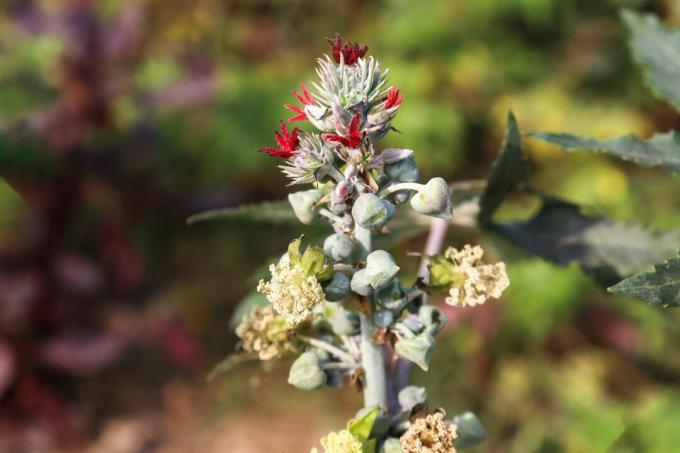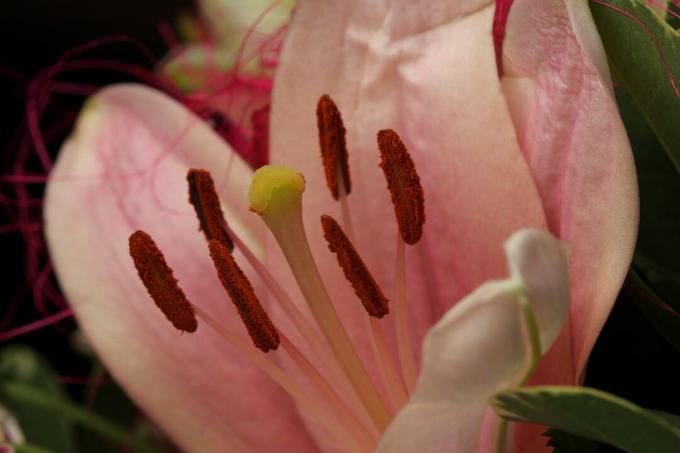The variety of plant blossoms is hardly manageable. Therefore there is the classification that plants can be monoecious, dioecious or hermaphrodite.

The jargon used by botanists can sometimes be a bit confusing. The terms "monoecious", "dioecious" and "hermaphrodite" are often heard in connection with pollination and fruit set. They describe the distribution of female and male floral organs on the plant. But what do the terms mean and what can we as gardeners deduce from them? This article provides clarity and provides valuable practical tips for your garden.
By the way: Irrespective of the abundance of the plants, they can be pollinated by wind or water as well as by insects. All types come with different ones types of pollination in front.
contents
-
What are monoecious plants?
-
Examples of monoecious plants
- monoecious trees
- Monoecious vegetable
- Planting tips
-
Examples of monoecious plants
-
What are hermaphrodite plants?
- Examples of hermaphrodite plants
- Usage Tips
-
What are dioecious plants?
- Examples of dioecious plants
- Planting tips
What are monoecious plants?
Monoecious plants bear both all-male and all-female flowers. Male flowers contain stamens that carry pollen. Female flowers can be recognized by the carpels, the so-called pistil, on the stigma of which the pollen is transferred. Monoecious plants can therefore be recognized by the fact that they form two different types of flowers.

Tip: The monoeciousness of plants is also referred to as monoecy in the technical language, which comes from ancient Greek and freely translated means "single" and "house". What is meant is that males and females are in the same house, i.e. that flowers of both sexes are on the same plant.
However, the male and female flowers of monoecious plants do not always appear at the same time, on the same branch, or even at every age of the crop. Because even if a plant develops both flower types, inbreeding must usually be avoided in order to produce healthy offspring. Therefore, many monoecious plants first develop the flowers of one sex, then the flowers of the other sex at different times (dichogamy).

Alternatively, they spatially separate flower types by being in different locations on the plant. As a rule, the male flowers that donate pollen are then arranged high up, so that their pollen is blown far away from their own female flower.
It also happens that plants only develop both types of flowers when they are old: it is important to develop fruit then give up the fully developed, adult plants – the younger specimens in the pollen donate Surroundings.
Last but not least, self-fertilization and inbreeding can also be prevented by a genetic barrier: So-called sterility genes block the growth of the pollen tube in the ovary of the female Blossom.

Examples of monoecious plants
Monoecious plants include many of our wild and cultivated plants, but also some exotic plants:
monoecious trees
- Jaw (Pinus)
- larch (larix)
- hazel (Corylus avellana)
- walnut (Juglans regia)
- alder (alnus)
- hornbeam (Carpinus betulus)
- birch (Betula)
- Most conifers (conifers)
- chestnut (Castanea sativa)

Monoecious vegetable
- watermelon (Citrullus lanatus)
- Corn (Zea mays)
- Cucumber (Cucumis sativus)
- pumpkin (Cucurbita spec.)
- zucchini (Cucurbita pepo convar. giromontiina)

Some plants were originally dioecious, but were selected for monoeciousness, i.e. deliberately bred. This has the advantage that a grower does not have to tend male plants that do not yield - only fruiting specimens. The Noble Vine (Vitis vinifera) and real hemp (Cannabis sativa) are two examples of cultivated monoecious plants.
Planting tips
Flowering of the plant occurs even if fertilization is not possible. So if you just want to enjoy the ornamental value of beautiful flowers, there is nothing special to consider when planting monoecious plants. But if you want to harvest fruit from a plant that is monoecious, you should find out beforehand. What matters is whether it is self-fertile or needs pollen from a foreign, genetically different individual to form healthy seeds.
monoecious nuts: Chestnuts, hazelnuts and walnuts, for example, grow dichogamously – male and female flowers do not appear at the same time. If there is no suitable pollen donor in the vicinity, the fruit set can be small or absent altogether.

Monoecious vegetables: Cucurbits such as cucumber, zucchini, and squash are capable of self-pollination. However, cross-pollination can improve fruit set. Corn is a cross-pollinator, so unless the neighbors grow corn, two different varieties should be grown. Basically, a high variety of varieties often has a positive effect on the yield.

What are hermaphrodite plants?
While pure female and pure male flowers are formed in monoecious plants of the same sex, hermaphrodite plants only have one type of flower - namely hermaphrodite. So these contain both the male and the female flower organs: carpels and stamens.

However, the fact that both organs are so close together does not mean that hermaphrodite flowers can fertilize themselves. There are self-fertile and non-self-fertile hermaphrodite plants.
If the hermaphroditic individual is self-fertile, pollination often takes place when the flower is closed – at the latest, however, when an insect moves around the flower collecting nectar. Pollen is transferred to your own stigma and fertilizes it. In many cases, however, inbreeding is avoided even with hermaphroditic plants: For example, through the sterility genes already mentioned, sometimes also in combination with so-called heterostyly. This can be observed very nicely in primroses: there are flowers with short and those with long pistils, which promotes cross-pollination and inhibits self-pollination.
However, self-fertilization is also possible: this is called autogamy. We find autogamous, i.e. self-fertile, plants in many gardens. For example tomatoes (Solanum lycopersicum), strawberries (Fragaria x pineapple) and most cherries (prunus spec.) are self-fertile, so they do not need a pollination partner.

tip: The vast majority of plants are monoecious or even hermaphroditic, namely about 95%. Incidentally, hermaphroditic plants are also monoecious by definition: after all, male and female flower organs are on the same plant.
Examples of hermaphrodite plants
The majority of our native plants and useful plants form hermaphrodite flowers:
- apple trees (penalty spec.)
- pear trees (Pyrus spec.)
- Cherry trees (prunus spec.)
- roses (pink)
- olive trees (Olea europaea)
- Most vegetables
- Many ornamental plants, for example daisies (Bellis perennis)

Usage Tips
Even with hermaphroditic plants, it is important to know whether or not they can successfully pollinate themselves if fruit and seeds are to be produced. If it is not the fruit of a vegetable, but another organ that is desired, harvested or eaten as an ornament, there is of course no need to look for a partner for fertilization.
Examples of self-fertile hermaphrodite crops:
- Tomatoes (Solanum lycopersicum)
- eggplant (Solanum melangena)
- Paprika (Capsicum annum)
- Lots of beans (phaseolus spec.)
- Peas (Pisum sativum)
- Lamb's lettuce (Valerianella locusta)
- Most strawberries (Fragaria x pineapple)
- All sour cherries and a few sweet cherry varieties: e.g. B. 'Stella' and 'Lapins'

Examples of cross-pollinated hermaphrodite crops:
- apples
- Most sweet cherries
- parsnip (Pastinaca sativa)
- leek (Allium porrum)
- Cabbage plants (Brassicacaea)
The flowering window is often not very long. In order for cross-pollination to be successful, the flowering times of the chosen strains must naturally overlap. Therefore, for many plants there are pollination tables to find out which varieties are suitable as pollinators.
Tip - Encourage pollination: Irrespective of whether plants are monoecious, dioecious or hermaphrodite: in most cases, cross-pollination leads to higher-quality fruit and often also to a higher yield. Because pollination is done by insects in so many cases, both home gardeners and professional fruit and vegetable growers encourage pollination by attracting insects. If you also want to encourage insects in your garden with a flower meadow, you can read our article on Creation of flower meadows read. Among other things, we present our Plantura bee pasture that contains seeds from over 20 different plants and is therefore a good basis for an ecologically valuable flowering area.

Plantura bee pasture
Over 20 annual & perennial species for
Bees, bumblebees & co, easier to care for
Blossom dream in bed, pot & window box
By the way: Classifying plants as monoecious, dioecious, and hermaphrodite is just a botanist's attempt to discern a system in nature's variability. But as always, exceptions confirm the rule, because no botanical system fits reality like a glove. Mixed forms often occur. An example is the horse chestnut (Aesculus hippocastanum), which can form both hermaphroditic, purely male and purely female flowers. Other plants are capable of producing hermaphroditic, male or female flowers.

What are dioecious plants?
Only about 5% of the plants are dioecious - that is, with male and female flowers on different specimens. So there are purely male and purely female plants. Dioecious has the advantage for the plant that self-pollination and thus inbreeding are completely excluded. An individual can only be fertilized by, or fertilize, another. This guarantees regular genetic mixing. In the case of dioecious plant species, fruiting can only ever be observed on the females, while the males produce ample pollen.
Tip: The dioeciousness of plants is also referred to as dioecy in technical jargon, which comes from ancient Greek and freely translated means "twice" and "house". The sexes are therefore in "two houses", namely on two different plants.

Examples of dioecious plants
Dioecious garden plants:
- willow (Salix caprea)
- holly (ilex spec.)
- ginkgo (Ginkgo biloba) – usually only males are planted
- sea buckthorn (Hippophae rhamnoides)
- kiwi (Actinidia deliciosa) – there are also monoecious varieties
- Campion (Silence dioica)
- cinquefoil (Potentialla futicosa) – usually only females are planted
- hops (Humulus lupulus)
- yew (Taxus baccata)
- skimmie (Skimmia japonica)
- Spinach (Spinacia oleracea)
- Some watermelon varieties
- asparagus (Asparagus officinalis)

Planting tips
If the goal of planting is to harvest or admire the fruit, both females and males must be planted in dioecious plants for fruit set to occur. Often a few male plants are sufficient for pollen production to fertilize many females.
Fruit set is desirable for some plants: who would want to do without the red berries of the yew, hollyhock or skimmie, let alone the tasty sea buckthorn or kiwi? In other plants, fertilization is better avoided. Ginkgo females form a number of very unpleasantly smelly fruits - this is why only male ginkgos are usually planted.

In some of the plants presented, only a few varieties have been bred in such a way that they are self-fertile or at least monoecious in order to simplify cultivation.
You don't know how exactly the terms "plant species" and "plant variety" differ? Then find out more in our special article about what exactly the Difference between plant species and varieties is.
...and receive concentrated plant knowledge and inspiration directly in your e-mail inbox every Sunday!



